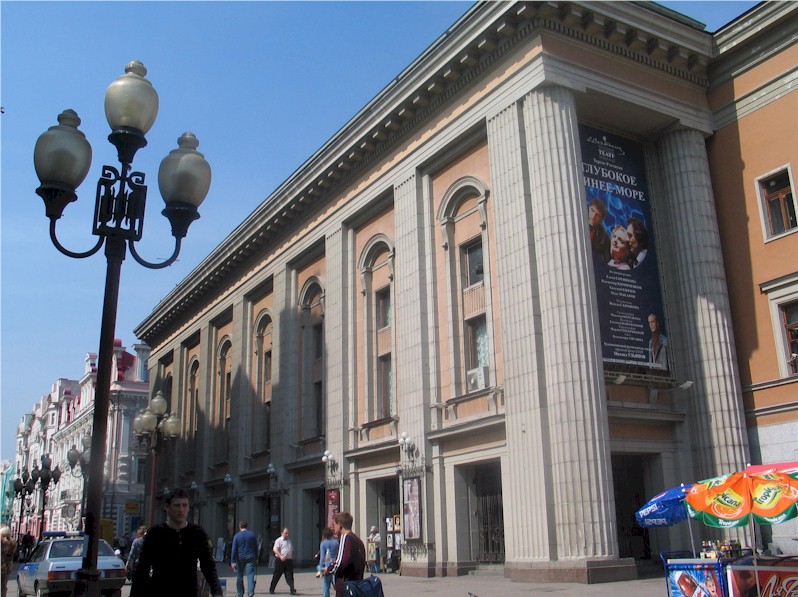Arbat
Arbat, probably the most touristic street of today's Moscow, appears often in The Master and Margarita. There are not many actions on the Arbat itself, but a lot is happening in the streets around. It's like the vein giving life to the characters of the novel. Ivan Bezdomny´s wild chase of Woland passes here, Margarita's flight on the broom too, and Margarita, with her spouse, «occupied the entire top floor of a magnificent house in a garden on one of the lanes near the Arbat».
Although today it's a typical touristic pedestrian shopping street, the Arbat was once the bohemian quarter of the city, with café's full of philosophing intelligentsia. The name Arbat sounds similar to the Arabic word arbad, meaning suburb. This could be an explanation of the name, since in the 15th century only the Kremlin was considered as the city center and the actual Arbat area was used by the big convoys coming from the east with their goods.
Since the 18th century, Arbat and its network of side-alleys became Moscow's most aristocratic and literary neighbourhood, and many intelligentsia wanted to live there. The famous poet Puchkin lived in number 53 with his bride, in the same house where Tchaikovsky stayed for some time.
The communist revolution in 1917 had quite some consequences for this area. Since it was considered as the neighbourhood of the aristocracy, who were labeled by the communists as enemies of the class. So their houses were expropriated on a broad scale and transmitted to the working class as communal apartments. The artists were forced to work according to the directives of the Communist Party and to follow the doctrine of social realism.
The writer Anatoly Naumovich Rybakov (1911-1998) described in his book Children of the Arbat, the first part of a semi-biographical trilogy, the life of the people living in the Arbat neighbourhood during the repression of Joseph Stalin (1878-1953) in the thirties. Children of the Arbat was written and distributed via samizdat in the 60's but was not published until 1987 despite been officially announced for publication in 1966 and 1978. In both cases the publication was at the very last moment cancelled by the Soviet Government.

The Vakhtangov Theatre on the Arbat
One of the best known victims of the rigid cultural policy on the Arbat was the famous constructivist architect Konstantin Stepanovich Melnikov (1890-1974). Close to the Arbat he built, in 1927, the only one private residence from after the revolution, it was a constructoin made of two cilinders, meant as the prototype for the future construction of houses in the new Russia. But Stalin didn’t like it too much and he decided to accept only social realism as the style for architecture, by which he ruined Melnikov’s career. Melnikov was kind of lucky though. He was allowed to live in his constructivist house until his dead and was never arrested. The Melnikov house is on the UNESCO World Heritage Site list, but it is very dilapidated and Melnikov’s heirs are fighting for the rights of ownership of the house.

The Melnikov house
New Arbat
More lasting damage was caused by the communists in and around the Arbat by the construction of a new highway right through the heart of the old Arbat neighbourhood. Early 1962 the construction of this road was ordered by Nikita Sergeevich Khrushchev (1894-1971) and hundreds of historical houses were destroyed by the bulldozers. On November 7 of the same year the annual parade in honour of the celebration of the October Revolution could go over the new Kalinin prospekt. But it would take until 1967 before this road was completely finished. The road goes parallel to the Arbat, so it would soon be called New Arbat. The main characteristic of the new road is formed by some twenty huge apartment buildings an many big shops, which had to give the neighbourhood the appearance of a super modern western street. After the collapse of the Soviet Union the street was officially named New Arbat.
In the early eighties the Arbat was transformed into a pedestrian zone which developed, in the atmosphere of glasnost and perestroyka, to a central point for street musicians, painters and artists, which appealed strongly to both the young Muscovites and the growing amount of foreign tourists. So the Arbat soon got the same reputation as it already had at the end of the nineteenth and the beginning of the twentieth century: it became the creative centre of Moscow again. But the rapid commercialisatoin of Moscow affected the Arbat too. Yet many street musicians find their way to the Arbat, and you can regularly hear the famous Arbat song written by Bulat Shalvovich Okudzhava (1924-1997): «Oh Arbat, my Arbat, you are my destiny, you are my happiness and my sorrow.»

Monument for Bulat Okudzhava
Metro: Арбатская (Arbatskaya), Смоленская (Smolenskaya)
English subtitles
All films based on The Master and Margarita have been subtitled by your webmaster in English, French, Dutch, German, Spanish and Italian. Click on the link belw to find them.
